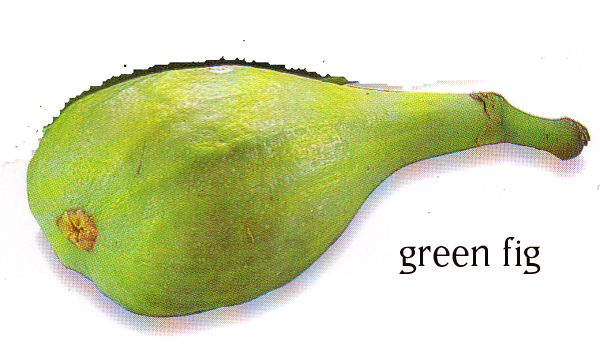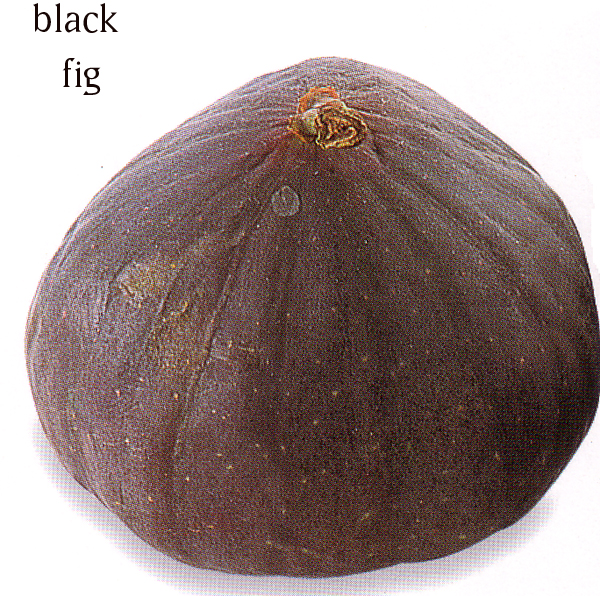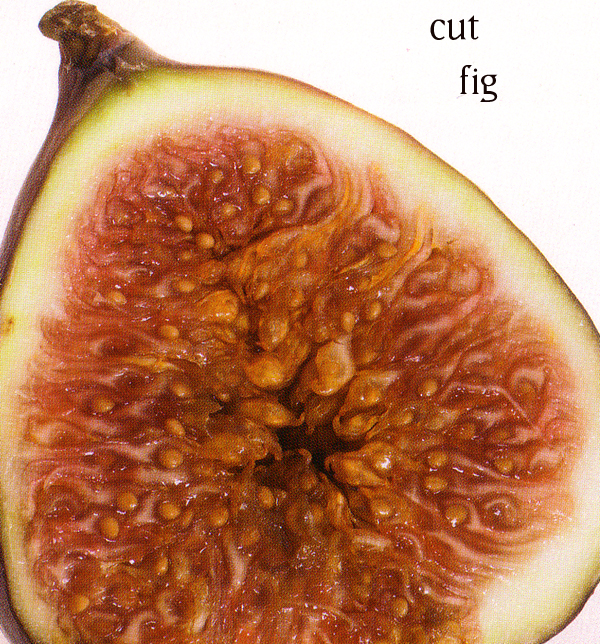
| What is Flavor and Fortune? |
| How do I subscribe? |
| How do I get past issues? |
| How do I advertise? |
| How do I contact the editor? |
Read 13112440 times
Connect me to:
| Home |
| Articles |
| Book reviews |
| Letters to the Editor |
| Newmans News and Notes |
| Recipes |
| Restaurant reviews |
| Article Index (all years, slow) |
| List of Article Years |
| Article Index (2026) |
| Article Index (last 2 years) |
| Things others say |
| Related Links |
| Log In... |
| Authors |
| Categories & Topics |
Figs
| by Jacqueline M. Newman |
Fruits, Desserts, and Other Sweet Foods
Fall Volume: 2008 Issue: 15(3) page(s): 11, 12, ans 13
Figs, most called wu hua in Chinese, are fascinating. Found wild and cultivated in many parts of the world, not all of them are edible. China has at least one hundred different species, most of theirs are edible, but some are varieties with not a single fruit. Plants of China by Hu, published in Hong Kong by Chinese University Press © 2005 was reviewed in Flavor and Fortune in Volume 12(4) on page 20, and it zeros in on fifteen of them, Ficus auriculata to Ficus tikoua. Most are shrubs or vines, a few are trees, all grow in semi-arid regions, are sensitive to frost, and have edible fruits. It is interesting to note that most of them are not popular in the United States where the best known fig is Ficus carica.
How long have figs been known in China? At least for hundreds and hundreds of years. They are there and all over Asia. The Chinese cook with them when fresh and Cantonese people adore adding dried ones to soups and stews for taste and for fitness. The Greeks and Romans thought the same.
Worldwide, some figs were found from the Cenozoic era sixty-five million years ago; but none in or near China. They were and are native to western Asia, well-distributed in the Mediterranean area, and found in several neolithic Eastern Mediterranean sites. The best known Western fig, the Ficus carioca, did not come to China until some time in the early Tang dynasty (618 - 907 CE); and it arrived already dried. By the 16th century, this fig and many others were planted around the lower Yangtze joining others there lots earlier.
Food historians know that fig trees, known as 'peepul' were the tree under which Buddha gained illumination. Called a 'puti' tree, a name derived from the Indian 'bodhi.' It also had another name, the 'bo' tree. One source commented that the first fig trees brought to China came with a priest from India and were probably Ficus retusa, which the Chinese called yung shu. This particular species is not listed in Hu's volume but is related to and now used as a shade tree in Southern China and Hong Kong.

 China's most popular fig is Ficus religiosa. It, too, is not in Hu's book, but is related to others found there. That may be why there is confusion about when and where figs first came to China. Some historians believe them indigenous, so they did not need to come, but were already there. Others say they came to China at different times. Clearly which figs and when are still being sorted out.
China's most popular fig is Ficus religiosa. It, too, is not in Hu's book, but is related to others found there. That may be why there is confusion about when and where figs first came to China. Some historians believe them indigenous, so they did not need to come, but were already there. Others say they came to China at different times. Clearly which figs and when are still being sorted out.
What everyone does agree upon is that figs are considered a 'flowerless fruit' with no visible blossoms. They also agree that this fruit has no known health hazards; and that figs are loaded with glucose, fructose and sucrose, all sugars. Figs are considered flowerless because their fruit forms before the flowers and actually surrounds them. Furthermore, fig plants are syconium while true fruits are drupelets. To add to the confusion, there are four different types of figs, only the common fig forms fruit without pollination. All the others need a female fig wasp to do the pollinating.
With or without knowledge of fig science, Chinese traditional medicine doctors have used different wild figs for many hundreds of years, They believe this fruit invigorates the spleen, moisten the bowels, induces urination, etc. They know that the fruit enters spleen, stomach, and intestinal channels, and is good to use when treating dry sore throats and coughs.
 Among the many kinds of figs are the apple fig--called ping guo rong, the creeping fig--called liang fen zi, and the climbing fig-- called bing fen shu. Chinese medicinal proactitioners (TCM doctors) recommend some of these for indigestion and constipation of the elderly, others for treating tuberculosis, hepatitis, and/or rheumatism. Some fig varieties are suggested to nursing mothers with insufficient breast milk, others recommended to those with sores that do not heal, and still others for those suffering with bladder infections. TCM practitioners suggest using dry fig leaves making a tea from all types of figs as they are considered relaxing, particularly in the evening. Western doctors advise patients to eat figs and other fruits for fiber, and believe they remove toxic body wastes and aid in reducing cholesterol.
Among the many kinds of figs are the apple fig--called ping guo rong, the creeping fig--called liang fen zi, and the climbing fig-- called bing fen shu. Chinese medicinal proactitioners (TCM doctors) recommend some of these for indigestion and constipation of the elderly, others for treating tuberculosis, hepatitis, and/or rheumatism. Some fig varieties are suggested to nursing mothers with insufficient breast milk, others recommended to those with sores that do not heal, and still others for those suffering with bladder infections. TCM practitioners suggest using dry fig leaves making a tea from all types of figs as they are considered relaxing, particularly in the evening. Western doctors advise patients to eat figs and other fruits for fiber, and believe they remove toxic body wastes and aid in reducing cholesterol.
Medicinally speaking, the Chinese consider figs neutral in nature and yang. They like to prescribe them for pain in the joints and as a wind-wetness cure. However, eating too many figs does cause diarrhea whether fresh, dried, or made into a tonic paste. The same is true should they recommend the roots as a cure for bladder infections.
Besides wu hua or wu hua guo, the Chinese call figs 'tree melons' or mu gua guo. They like them raw and process seeds of some of them to make a jelly. This aspect of the Ficus pumila variety making grass jelly; that was discussed in Volume 13(2) on page 31, and in Volume 14(1) on pages 22 and 23. Most lesser known figs, fig seeds, fig vines, and fig leaves are consumed close to where they grow. Many are processed and used and are not recognizable fruit, as is the above mentioned jelly.
In China, other popular figs are Ficus auriculata and Ficus awkeotsang. The former is from a tree, the latter from an evergreen vine. The common western fig, Ficus carica, is from a tree and can be found fresh in China, but more often it is found dried. As Hu points out in her book, there are many fig varieties including Ficus chlorocarpa. That one is from a tree and native to southeastern China; Ficus esquiroliana is native to Hong Kong, Ficus henryi well-known to those in Hubei and the southern part of the Sichuan province, and Ficus oligodon---the apple fig, popular in China’s southwest and Tibet’s southeast.
All figs have a short season. Ripe ones can be frozen or prepared in any number of preparations for later use, and all can be dried. Some fig trees, bushes, and vines have two fruiting seasons a year with a small crop at the end of winter called Breba and the main harvest, depending upon variety and climactic zone, from late spring through summer. The figs picked or processed in spring or summer have no special name as do winter figs.
When ripe, figs need to be picked daily because they do not stay well on tree or vine. They are best eaten up to five days after they turn ripe whether on or off the plant, and it is best to keep them cool or refrigerated after they ripen.
Nutritionally speaking, figs contain almost no fat, sodium, or cholesterol. They have lots of dietary fiber, perhaps the highest of any fruit, and their sugar content is more than fifty percent by weight so they have many calories; and they are a good source of calcium. A medium-size fig has about eighteen milligrams of calcium, and lots of pectin; when cooked it softens. In addition, figs are excellent sources of iron.
FIG JUICE, the Chinese use to treat warts. They use unripe fruits and squeeze them. However, to treat these growths, TCM doctors say to rub this liquid on the warts twice a day and let this liquid dry naturally.
FIG SOUP is given to those with rheumatism. They are told to take three very large figs (close to half a cup and mash them). To use this mash, cook it with a like amount of pork, and one egg, then add two tablespoons of Chinese rice wine and one-quarter cup water and simmer this mixture for an hour or until the pork is very tender. Recommended, is to eat this soup for dinner every evening, and for lunch and dinner on rainy days.
FIG STEW is used to increase breast milk, is prepared daily by cooking two figs and two Chinese dates with one-quarter pound minced pork and one cup of water. Simmer this for twenty minutes and consume it at one sitting, preferably early in the day.
FIG TONIC is made and given to the elderly and those with minor malaise, is made with a pound of dried figs simmered in water until the figs become paste-like. While hot, a cup of sugar is added and stirred until the sugar dissolves. Then cool and refrigerate, it lasts for months. TCM doctors recommend two or three tablespoons twice a day as a great pick-me-up.
| Fruit Soup, Hubei-style |
|---|
1/2 pound dried regular or white figs, stems discarded 1/2 pound dried lotus seeds, pits removed and discarded 1/2 pound dried longan pulp 24 Chinese red dates, pits removed and discarded 1/4 pound white rock sugar 2 Tablespoons goji berries Preparation: 1. Soak figs and lotus seeds separately in two cups of water each, for twenty-four hours. Discard the lotus seed water but keep the water from the figs. 2. Boil the lotus seeds in four cups of water for half an hour then simmer them for two hours, or until they are soft, even falling apart. The water will almost boil away. 3. Put the remaining lotus seeds and water, and the figs and their water into a heat-proof bowl. Add the longan pulp and the red dates, and steam, covered over boiling water for twenty minutes. Then add two cups of boiling water and the goji berries and steam everything another five minutes. Serve hot, warm, or cold. |
| Chicken Ball and Fig Soup |
|---|
1/2 skinless and boneless chicken breast (five to six ounces) 2 dried figs, soaked for two hours, stems removed and discarded 2 Chinese dried black mushrooms, soaked until soft, stems removed and discarded 1 teaspoon dried shrimp, soaked for ten minutes 1/4 cup canned water chestnuts 3 and 1/2 cups chicken broth 2 teaspoons thin soy sauce 1/2 teaspoon oyster flavored sauce 1 Tablespoon cornstarch Preparation: 1. Mince chicken breast, figs, mushrooms, dried shrimp, and water chestnuts separately, then gently mix them and add half cup of broth and the soy and the oyster sauces. Make into four large balls. Dust them with the cornstarch and let them air dry about forty minutes. 2. Bring the remaining chicken broth to a simmer, do not boil it. One by one, put a chicken ball on a spoon, and lower it into the simmering broth. Simmer them for twenty minutes, being sure the broth does not boil. Remove each one to a Chinese soup bowl and ladle the broth over them, Then serve. |
| No-yolk Eggs with Figs |
|---|
8 eggs 1 dried fig, stem removed 1/2 teaspoon cornstarch 1 cup chicken broth 1 teaspoon vegetable oil 1 pound pea shoot leaves Preparation 1. Make a small hole in the wide end of the egg shell, and pour the egg white into one bowl, the yolk into another one. Repeat until all egg shells are empty. Carefully rinse them out with cold water, and put the shells into a large heat-proof soup bowl filled with rice, hole side up. 2. Mince the fig and add the cornstarch, then mince it even finer. Put this into a measuring cup with a pour spout and mix in the egg whites and the chicken broth. Pour this mixture into each of the egg shells. 3. Steam them over simmering water for one half an hour. Then remove the eggs and allow them to cool in a bowl of cold water. Peel them slowly and carefully so as not to ruin their shape. When peeled, put them into a bowl of hot water to warm them. 4. Next, beat one quarter of the egg yolks with two tablespoons of cold water. Refrigerate the rest for another use. 5. Heat oil in a wok or fry pan. Then without stirring them, cook the egg yolks until set. Do not turn them over, but when they are set, put this egg pancake on a cutting board and cut it into thin slivers, about two inches long and as thin as you can make them (less than an eighth of an inch wide). Set them aside. 5. In the same wok or frypan, fry the pea shoots for one minute, then add two tablespoons of water and stir-fry another minute until wilted. 6. Put pea shoots on a pre-heated platter, nestle the drained eggs among them, and sprinkle the shredded yolk strips around the outside, and serve. |
| Figs in Hotpot |
|---|
1 cup dried whole figs, stems removed, each one cut in half 1/4 cup bamboo shoots 2 twelve-inch lengths pig intestine, rinsed then blanched for two minutes(approximately one-quarter pound) 1 scallion, minced 1 Tablespoon vegetable oil 2 cloves garlic, peeled and sliced 1 Tablespoon oyster sauce 1 Tablespoon Chinese rice wine 1/2 cup water or fig juice Preparation: 1. Soak figs in warm water for one hour, then drain. This water can be saved and used as the needed fig juice. 2. Coarsely chop the bamboo shoots and cut the intestines into two-inch lengths. 3. Cook the intestines with the scallion and ginger pieces until they are tender, about an hour. 4. Put oil in the hot pot or casserole. Add bamboo shoots, pieces of intestine, and the garlic slices. Then add oyster sauce, rice wine, and the fig juice, and one cup of water. Cover and simmer for one hour, remove the cover and simmer another half hour to reduce the liquid, then serve. |

Copyright © 1994-2026 by ISACC, all rights reserved
Address
3 Jefferson Ferry Drive
S. Setauket NY 11720